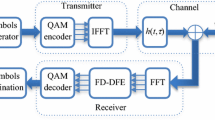Abstract
This paper addresses receiver related side information (SI) estimation issues when selected mapping is used to reduce peak-to-average power ratio in orthogonal frequency division multiplexing (OFDM) systems. The SI contains critical information and its accurate estimation is required to enable successful recovery of payload data regardless of the channel condition. However, the need for SI estimation poses some practical issues in the form of high computational complexity and implementation challenges. Through simulations, this paper investigates the performance of an alternative data decoding approach called Embedded Coded Modulation (ECM), which requires no SI estimation. Using a form of block-type OFDM frame structure, results show that the ECM technique produces identical data decoding performance as other methods even in the presence of some non-linear amplifier distortions. In addition, it is shown that the ECM method eliminates SI related computational complexity and implementation problems.






Similar content being viewed by others
References
Miridakis, N. I., & Vergados, D. D. (2013). A survey on the successive interference cancellation performance for single-antenna and multiple-antenna OFDM systems. IEEE Communications Surveys Tutorials, 15(1), 312–335.
Adegbite, S. A., McMeekin, S. G., & Stewart, B. G. (2015). Time-domain SI estimation for SLM based OFDM systems without SI transmission. Wireless Personal Communications, 85(3), 1193–1203.
Baig, I., & Jeoti, V. (2013). A ZCMT precoding based multicarrier OFDM system to minimize the high PAPR. Wireless Personal Communications, 68(3), 1135–1145.
Lee, B. M., de Figueiredo, R. J., & Kim, Y. (2012). A computationally efficient tree-PTS technique for PAPR reduction of OFDM signals. Wireless Personal Communications, 62(2), 431–442.
Jiang, T., & Wu, Y. (2008). An overview: Peak-to-average power ratio reduction techniques for OFDM signals. IEEE Transactions on Broadcasting, 54(2), 257–268.
Rahmatallah, Y., & Mohan, S. (2013). Peak-to-average power ratio reduction in OFDM systems: A survey and taxonomy. IEEE Communications Surveys Tutorials, 15(4), 1567–1592.
Han, S. H., & Lee, J. H. (2005). An overview of peak-to-average power ratio reduction techniques for multicarrier transmission. IEEE Wireless Communications, 12(2), 56–65.
Bauml, R. W., Fischer, R. F. H., & Huber, J. B. (1996). Reducing the peak-to-average power ratio of multicarrier modulation by selected mapping. Electronics Letters, 32(22), 2056–2057.
Baxley, R., & Zhou, G. (2007). Comparing selected mapping and partial transmit sequence for PAR reduction. IEEE Transactions on Broadcasting, 53(4), 797–803.
Ogunkoya, F., Popoola, W., Shahrabi, A., & Sinanovic, S. (2015). Performance evaluation of pilot-assisted PAPR reduction technique in optical OFDM systems. IEEE Photonics Technology Letters, 27(10), 1088–1091.
Ji, J., Ren, G., & Zhang, H. (2015). A semi-blind SLM scheme for PAPR reduction in OFDM systems with low-complexity transceiver. IEEE Transactions on Vehicular Technology, 64(6), 2698–2703.
Adegbite, S. A., McMeekin, S. G., & Stewart, B. G. (2014). Low-complexity data decoding using binary phase detection in SLM–OFDM systems. Electronics Letters, 50(7), 560–562.
Jayalath, A. D. S., & Tellambura, C. (2005). SLM and PTS peak-power reduction of OFDM signals without side information. IEEE Transactions on Wireless Communications, 4(5), 2006–2013.
Park, J., Hong, E., & Har, D. (2011). Low complexity data decoding for SLM-based OFDM systems without side information. IEEE Communications Letters, 15(6), 611–613.
Hong, E., Kim, H., Yang, K., & Har, D. (2013). Pilot-aided side information detection in SLM-based OFDM systems. IEEE Transactions on Wireless Communications, 12(7), 3140–3147.
Coleri, S., Ergen, M., Puri, A., & Bahai, A. (2002). Channel estimation techniques based on pilot arrangement in OFDM systems. IEEE Transactions on Broadcasting, 48(3), 223–229.
ETSI European Standard EN 302 755 v1.3.1, Digital Video Broadcasting (DVB). (2012). Frame structure channel coding and modulation for a second generation digital terrestrial television broadcasting system (DVB-T2).
Zhou, G. T., & Peng, L. (2006). Optimality condition for selected mapping in OFDM. IEEE Transactions on Signal Processing, 54(8), 3159–3165.
Popoola, W., Ghassemlooy, Z., & Stewart, B. (2014). Pilot-assisted PAPR reduction technique for optical OFDM communication systems. Journal of Lightwave Technology, 32(7), 1374–1382.
Stearns, S., & Hush, D. (2002). Digital signal processing with examples in MATLAB®. Boca Raton, FL: Taylor & Francis.
Peled, A., & Ruiz, A. (1980). Frequency domain data transmission using reduced computational complexity algorithms. In Acoustics, speech, and signal processing, IEEE international conference on ICASSP ’80 (Vol. 5, pp. 964–967).
Jiang, T., Guizani, M., Chen, H.-H., Xiang, W., & Wu, Y. (2008). Derivation of PAPR distribution for OFDM wireless systems based on extreme value theory. IEEE Transactions on Wireless Communications, 7(4), 1298–1305.
Adegbite, S. A., McMeekin, S., & Stewart, B. G. (2014). Performance of a new joint PAPR reduction and SI estimation technique for pilot-assisted SLM–OFDM systems. In 2014 9th IEEE/IET international symposium on communication systems, networks digital signal processing (CSNDSP) (pp. 308–313).
Joint Technical Committee (JTC) on Wireless Access. (1994). Final Report on RF Channel Characterisation.
Rapp, C. (1991). Effects of HPA nonlinearity on a 4-DPSK/OFDM signal for a digital sound broadcasting system. In Proceedings of 2nd European conference on satellite communication, Liege (pp. 179–184).
Author information
Authors and Affiliations
Corresponding author
Rights and permissions
About this article
Cite this article
Adegbite, S.A., McMeekin, S. & Stewart, B.G. Computational Efficient SLM–OFDM Receiver for Time-Invariant Indoor Fading Channel. Wireless Pers Commun 97, 661–674 (2017). https://doi.org/10.1007/s11277-017-4529-0
Published:
Issue Date:
DOI: https://doi.org/10.1007/s11277-017-4529-0




